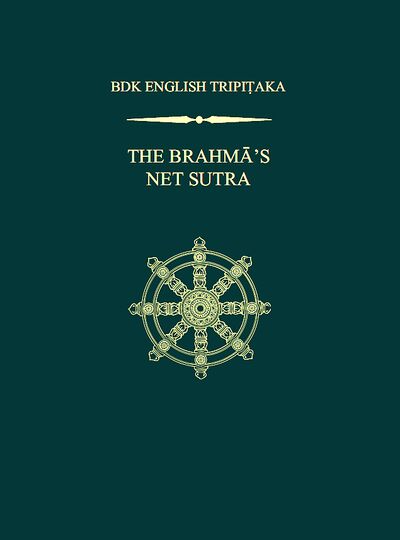The Brahmā's Net Sutra
< Books
(Created page with "{{Book |FullTextRead=No |TextTranslated=Texts/Fanwang jing |StopPersonRedirects=No }}") |
|||
| Line 2: | Line 2: | ||
|FullTextRead=No | |FullTextRead=No | ||
|TextTranslated=Texts/Fanwang jing | |TextTranslated=Texts/Fanwang jing | ||
| + | |BookToc=*{{i|A Message on the Publication of the English Tripiṭaka, ''NUMATA Yehan''|v}} | ||
| + | *{{i|Editorial Foreword, ''Kenneth K. Tanaka''|vii}} | ||
| + | *{{i|Publisher's Foreword, ''A. Charles Muller''|ix}} | ||
| + | *{{i|Translators' Introduction, ''A. Charles Muller'' and ''Kenneth K. Tanaka''|xvii}} | ||
| + | |||
| + | *The Brahmā's Net Sutra | ||
| + | *Fascicle 1. Exposition of the ''Brahmā's Net Sutra'' | ||
| + | **{{i|(Preface)|3}} | ||
| + | **{{i|Preface to the ''Brahmā's Net Sutra'' by Śramaṇa Sengzhao|3}} | ||
| + | **{{i|The Forty Stages|4}} | ||
| + | ***{{i|(Convocation)|4}} | ||
| + | ***{{i|Ten Departures for the Destination|6}} | ||
| + | ***{{i|Ten Nourishing Mental States|6}} | ||
| + | ***{{i|Ten Adamantine Mental States|6}} | ||
| + | ***{{i|Ten Grounds|7}} | ||
| + | **{{i| The Ten Departures toward the Destination|8}} | ||
| + | ***{{i|1. The Mental State of Detachment|8}} | ||
| + | ***{{i|2. The Mental State of Morality|8}} | ||
| + | ***{{i|3. The Mental State of Patience|9}} | ||
| + | ***{{i|4. The Mental State of Zeal|9}} | ||
| + | ***{{i|5. The Mental State of Concentration|10}} | ||
| + | ***{{i|6. The Mental State of Insight|10}} | ||
| + | ***{{i|7. The Mental State of Making Vows|11}} | ||
| + | ***{{i|8. The Mental State of Guarding|11}} | ||
| + | ***{{i|9. The Mental State of Joy|12}} | ||
| + | ***{{i|10. The Summit Mental State|12}} | ||
|StopPersonRedirects=No | |StopPersonRedirects=No | ||
}} | }} | ||
Revision as of 14:25, 27 July 2021
The Brahmā’s Net Sutra is the primary extant vinaya text that articulates a set of precepts from a Mahayana perspective, mainly intended for "bodhisattva practitioners" primarily householders, rather than renunciant monks or nuns. Before the appearance of this text the monastic rules and regulations in East Asian Buddhism were defined fully by the "Hinayana" vinaya, most importantly the Four-part Vinaya associated with the Dharmaguptaka school in India. With the appearance of the Brahmā’s Net Sutra many East Asian schools diversified their precept practices, with some groups of practitioners taking up either set of precepts, often utilizing both.
Composed in China around 420, the Brahmā’s Net Sutra is based on various contemporary Mahayana and Hinayana vinaya writings and includes extensive discussion of indigenous Chinese moral concepts such as filial piety, etc. The text is based in the same mainstream Mahayana thought of the Flower Ornament Sutra (Huayan jing), the Nirvana Sutra (Niepan jing), and the Sutra for Humane Kings (Renwang jing). In fact, the extent of the Brahmā's Net Sutra's agreement with the Flower Ornament Sutra is so pronounced that it is regarded as the "concluding sutra" of the latter.
Long thought to be the Skt. Brahmajāla-sūtra translated by Kumārajīva into the Chinese as Fanwang jing (梵網經), the work is now seen within modern scholarship as composed in China around 420, based on various Mahayana and Hinayana vinaya writings available at that time. 2 fascicles. (Source: BDK America)
| Citation | Muller, A. Charles, and Kenneth K. Tanaka, trans. The Brahmā's Net Sutra: (Taishō Volume 24, Number 1484). Moraga, CA: BDK America, 2017. |
|---|---|

